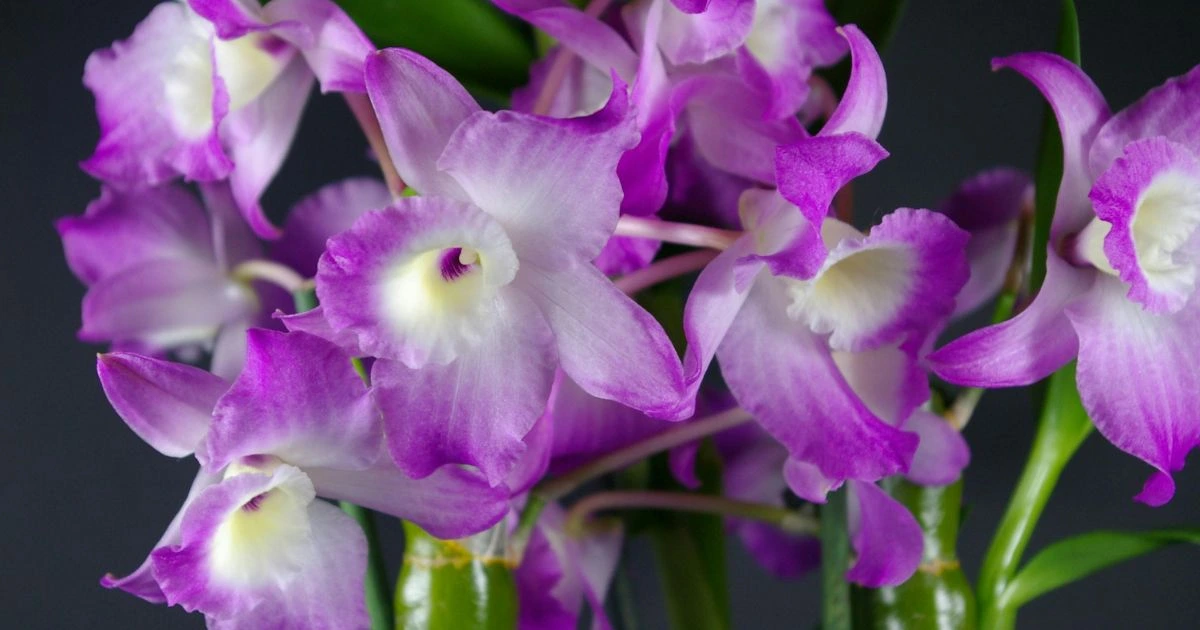In This Article
Imagine a plant that embodies resilience, elegance, and vibrant beauty—a living masterpiece that brings joy to your garden or home. That’s the allure of dendrobium orchids. Whether you’re a seasoned gardener or just beginning your plant journey, these exotic blooms have a way of connecting with your heart. They tell a story of nature’s brilliance and remind us of the beauty we can nurture in our own lives. Ready to dive into the fascinating world of dendrobium orchids? Let’s explore their charm and learn how to make them thrive.
| Common Name | Dendrobium Orchid |
| Botanical Name | Dendrobium spp. |
| Family | Orchidaceae |
| Plant Type | Perennial, Epiphytic Orchid |
| Mature Size | 6 inches to 4 feet (depending on species) |
| Bloom Time | Spring, Summer, Fall (varies by species) |
| Toxicity | Non-toxic to humans and pets |
| Sun Exposure | Bright, indirect sunlight |
| Soil Type | Well-draining orchid mix (bark, sphagnum moss) |
| Soil pH | Acidic (5.5–6.5) |
| Flower Color | White, Yellow, Orange, Green, Pink, Purple |
| Hardiness Zones | USDA Zones 9–12 |
| Native Area | Southeast Asia, Australia, Pacific Islands |
| Watering Needs | Water every 7–10 days, allowing medium to dry |
| Humidity | Moderate to high (50–70%) |
| Temperature Range | 60–80°F (prefers warm conditions) |
| Propagation Methods | Division, Keikis (baby orchids) |
| Special Features | Long-lasting blooms, fragrant varieties, low maintenance |
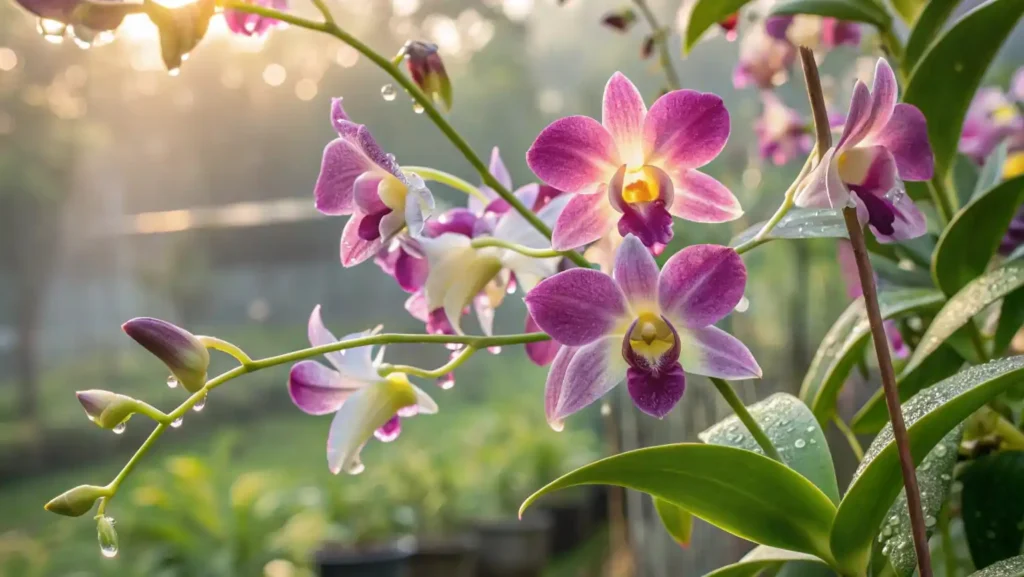
What is a Dendrobium Orchid?
One of the most captivating members of the orchid family. With over 1,500 species originating from tropical and subtropical regions like Southeast Asia, Australia, and the Pacific Islands, dendrobium orchids are a true testament to nature’s beauty. These plants are celebrated for their vibrant blooms, unique shapes, and ability to thrive in various conditions, making them a popular choice among gardeners in the USA.
What sets dendrobium orchids apart is their versatility. They can be grown indoors in pots or outdoors in suitable climates, such as USDA zones 9–11. These orchids are known for their elongated stems, called canes, which hold clusters of stunning flowers that come in an array of colors like pink, purple, white, and yellow. The blooms, often lasting several weeks, add a touch of elegance to any space.
Dendrobium orchids appeal to gardeners of all skill levels. Beginners appreciate their relatively low-maintenance nature, while seasoned plant enthusiasts enjoy the challenge of growing rarer species or achieving multiple blooms each year. They are also a favorite in floral arrangements due to their striking beauty and longevity.
Whether you’re a hobbyist or a professional gardener, orchids offer something special. They symbolize beauty, strength, and resilience—qualities reflected in their ability to adapt to different environments.
As you explore the world of dendrobium orchids, you’ll discover their unique characteristics and the joy they bring to your garden or home. With proper care, these stunning plants can flourish, providing breathtaking blooms and a sense of accomplishment.
Ready to start your journey with dendrobium orchids? Keep reading to uncover expert tips to grow, care for, and enjoy these amazing plants.
Why Choose Dendrobium Orchids for Your Garden?
Being a perfect choice for gardeners looking to add a touch of elegance and exotic beauty to their spaces, these stunning plants aren’t just visually captivating—they’re also versatile, low-maintenance, and incredibly rewarding to grow, making them ideal for both beginners and experienced plant enthusiasts.
One of the standout features of dendrobium orchids is their vibrant and diverse blooms. Available in colors like purple, pink, white, and yellow, their flowers create an eye-catching display in any garden or home. Their unique structure, with tall, slender stems and clustered blooms, adds a sophisticated charm to indoor spaces or outdoor landscaping.
Easy to care for, they adapt well to a range of conditions and thrive in both pots and gardens, as long as they have the right light, water, and humidity levels. Their long blooming period means you can enjoy their beauty for weeks, and they’re known to rebloom with proper care.
Whether you want to elevate your garden’s aesthetic or add a pop of color to your living room, dendrobium orchids are a great option. They’re not just plants—they’re a statement of natural elegance that brings joy year-round.
How to Plant Dendrobium Orchids (Step-by-Step Guide)
Planting dendrobium orchids is an enjoyable and straightforward process that sets the foundation for healthy growth and beautiful blooms. Whether you’re a beginner or an experienced gardener, following these steps will help your plant thrive.
Choosing the Right Pot and Medium
Start by selecting a pot with adequate drainage. Orchids dislike sitting in water, so a pot with multiple holes ensures excess water flows out. Clear plastic pots are a great option because they allow you to monitor root health.
For the potting medium, they prefer a well-draining mix. Opt for orchid-specific bark, sphagnum moss, or a combination of both. These materials mimic the orchid’s natural environment and allow roots to breathe.
Planting Steps
- Prepare the Potting Medium: Soak the bark or moss in water for 15–20 minutes before use to ensure it’s moist but not soggy.
- Position the Orchid: Place the dendrobium in the pot with its roots spread naturally. To prevent rot, avoid burying the stem too deeply.
- Fill with Medium: Gently pack the potting medium around the roots, leaving enough space for air circulation. Avoid compacting the medium too tightly.
Placement and Care After Planting
Once potted, place your dendrobium in a location with bright, indirect sunlight. Ensure the temperature is between 60–80°F and maintain moderate humidity to help the orchid acclimate. Water sparingly at first, allowing the roots to establish.
By following these steps, you’ll create the perfect environment for your plant to flourish. Proper planting not only ensures a healthy start but also sets the stage for vibrant blooms that will enhance your garden or home.
Essential Care Tips for Dendrobium Orchids
Caring for dendrobium orchids is simpler than you might think, as these beautiful plants thrive with just a little attention to their needs.
Light Requirements
Dendrobiums love bright, indirect sunlight. Place them near an east or south-facing window where they can soak up filtered light. Too much direct sunlight can scorch their leaves, while insufficient light may prevent blooming.
Watering Schedule
Water your plant once every 7–10 days, allowing the potting medium to dry out between waterings.
Temperature and Humidity
These orchids prefer temperatures between 60–80°F and a humidity level of 50–70%. Use a humidifier or misting to maintain the right environment, especially in drier climates.
With proper care, your plant will reward you with stunning, long-lasting blooms that brighten any space.
Common Problems and How to Fix Them
Caring for dendrobium orchids is generally straightforward, but you might encounter some common issues. Understanding these problems and knowing how to address them will keep your orchids healthy and blooming beautifully.
Yellowing Leaves
- Causes: Overwatering or insufficient light.
- Solutions: Ensure you’re watering your plant only once every 7–10 days and provide bright, indirect sunlight.
Bud Blast (Premature Dropping of Buds)
- Causes: Temperature fluctuations or low humidity.
- Solutions: Maintain a stable temperature between 60–80°F and keep humidity levels around 50–70%. Use a humidifier or mist the plant regularly to prevent bud drop.
Pests
- Common Pests: Aphids, mealybugs, and spider mites.
- Solutions: Inspect your plant regularly. Use neem oil or insecticidal soap as treatment of infestations. Removing pests early helps prevent serious damage.
Root Rot
- Causes: Poor drainage and excessive moisture.
- Solutions: Use a well-draining potting mix and pots with drainage holes. Allow the medium to dry out between waterings to prevent roots from becoming waterlogged.
By addressing these common problems promptly, your orchid will remain healthy and continue to produce stunning blooms year after year.
Propagation Made Easy
Propagating dendrobium orchids is an exciting way to expand your collection or share these stunning plants with friends. With the right techniques, propagation can be simple and rewarding.
Dividing Dendrobiums
One of the easiest methods is dividing mature plants. After your plant finishes blooming, carefully remove it from its pot and separate the clumps of canes. Ensure each division has healthy roots and at least three canes to support growth. Repot the sections in fresh orchid mix and water lightly.
Using Keikis (Baby Orchids)
Dendrobiums naturally produce keikis, or baby plants, on their stems. Once a keiki develops roots about 2 inches long, gently detach it from the parent plant. Pot the keiki in a small container with orchid bark and provide the same care as an adult dendrobium.
By propagating dendrobium orchids, you’ll enjoy even more of these beautiful blooms while learning more about their fascinating growth process.
Dendrobium Varieties to Try
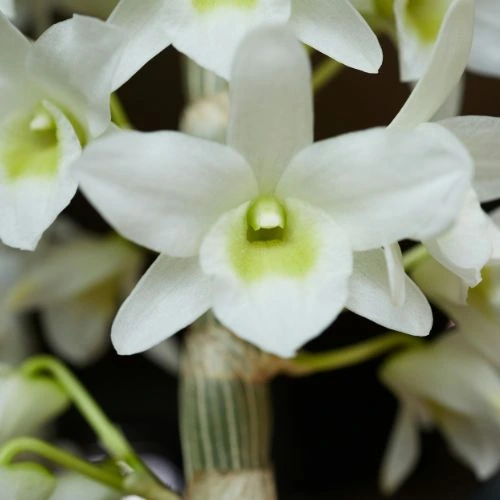
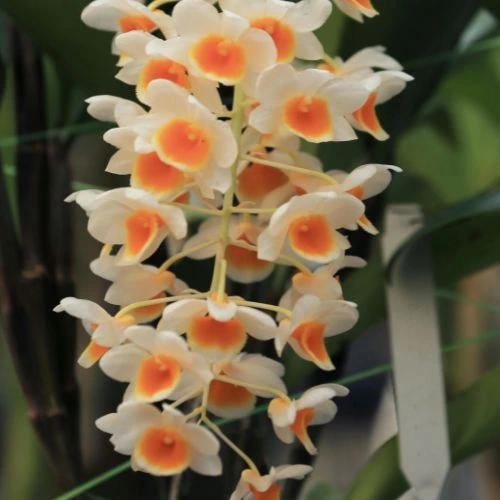
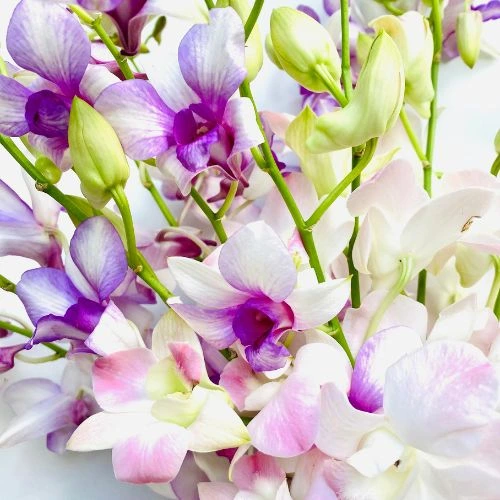
With over 1,500 species, dendrobium orchids offer a stunning variety of shapes, colors, and care needs. Whether you’re a beginner or an experienced gardener, there’s a dendrobium variety that will captivate you :
Dendrobium Nobile
Known for its vibrant, fragrant blooms, this variety produces flowers along its canes, creating a cascading effect. It’s a favorite for its striking purple and white petals and relatively easy care requirements.
Dendrobium Phalaenopsis
Often called the “butterfly orchid,” this type features large, long-lasting flowers that resemble moths or butterflies. Its bright colors, ranging from pink to purple, make it a standout in floral arrangements.
Dendrobium Kingianum
This variety, also called the “pink rock orchid,” is compact and highly fragrant. Its small, delicate blooms make it an excellent choice for indoor gardeners or those with limited space.
Dendrobium Chrysotoxum
For a golden touch, this species showcases clusters of bright yellow blooms with a sweet fragrance. It’s challenging to grow but highly rewarding.
By exploring these varieties, you’ll find a dendrobium orchid that matches your style and skill level, bringing vibrant beauty to your garden or home.
FAQs
Why isn’t my dendrobium orchid blooming?
Lack of blooms is often due to insufficient light. Ensure your plant receives bright, indirect sunlight. Additionally, feed it with a balanced orchid fertilizer monthly and maintain stable temperatures between 60–80°F.
Can dendrobium orchids grow outdoors?
Yes, orchids thrive outdoors in USDA zones 9–11. Place them in a shaded area with filtered light and maintain moderate humidity for optimal growth.
Do dendrobium orchids need special pots?
While not mandatory, using a pot with good drainage is essential. Clear plastic pots can help monitor root health, but decorative ceramic pots with drainage holes also work well.
Conclusion
Dendrobium orchids are more than just plants—they’re a celebration of nature’s elegance and your ability to create beauty around you. By understanding their care, tackling common problems, and exploring their varieties, you’ll enjoy the satisfaction of growing these stunning orchids. Ready to take your gardening passion further? Subscribe to our newsletter for expert tips, inspiring ideas, and the latest in hybrid gardening innovations. Let’s grow together!

